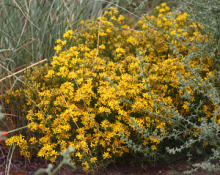Article
A flowering shrub (Gutierrezia sarothrae) found in the western half of the United States, often growing in arid grasslands or on mountain sides. This flowing plant is perennial, meaning it grows for more than two years. Often perceived as a weed, snakeweed can be mistaken for Rabbitbrush, which does not flower. Snakeweed can be toxic to sheep if eaten in great amounts; however, American Pronghorn prefer this shrub for browsing.
Snakeweed is often used for medicinal purposes by various Native American tribes. For instance, the Navajo use the ashes of this shrub to relieve dizziness and headaches and use chewed snakeweed on insect stings to reduce swelling and irritation. The Lakota use this plant as a horse laxative. Snakeweed is also used for Navajo ceremonials and chants. In the Mountain Chant Ceremony, for example, snakeweed is burned to charcoal, along with other shrubs, and used to cover the body of the patient. Snakeweed can also be used as an emetic, something that causes vomiting, in night ceremonials and to help deliver the placenta after childbirth.
"Gutierrezia sarothrae Broom Snakeweed" by Petrified Forest is licensed under CC BY.
Manuscripts
References
Anderson, M. Kat
2002 BROOM SNAKEWEED USDA National Plant Data Center.
http://plants.usda.gov/plantguide/pdf/cs_gusa2.pdf, accessed February 11, 2015.
Elmore, Francis H.
1943 Ethnobotany of the Navajo. Albuquerque: University of New Mexico Press.
Wyman, Leland Clifton and Stuart Kimball Harris
1941 Navajo Indian Medical Ethnobotany. Albuquerque: University of New Mexico Press.

